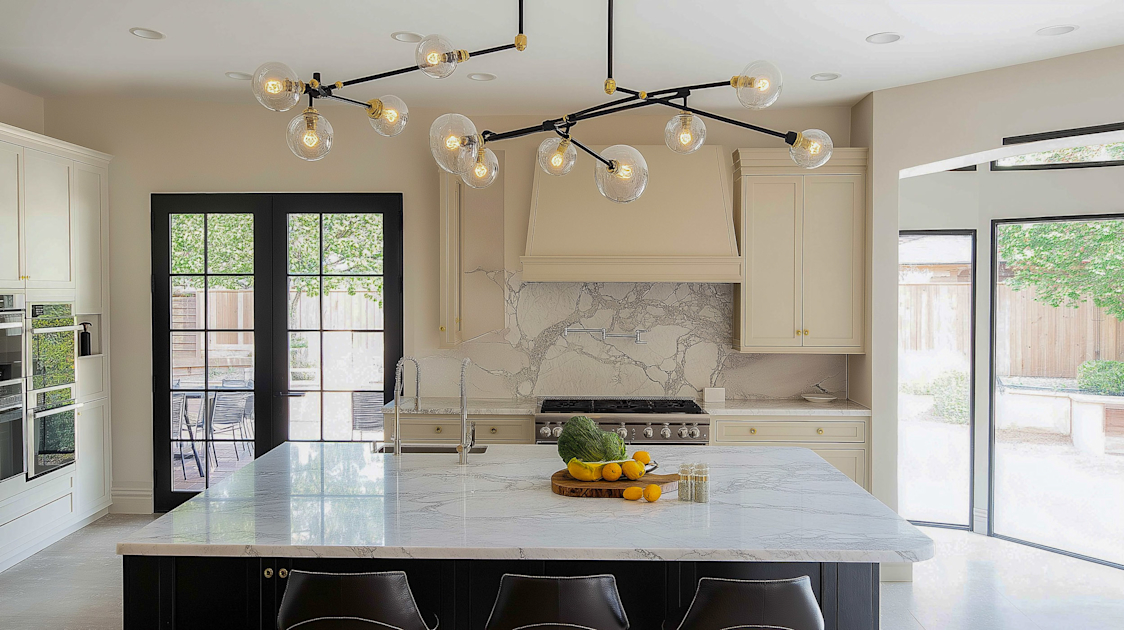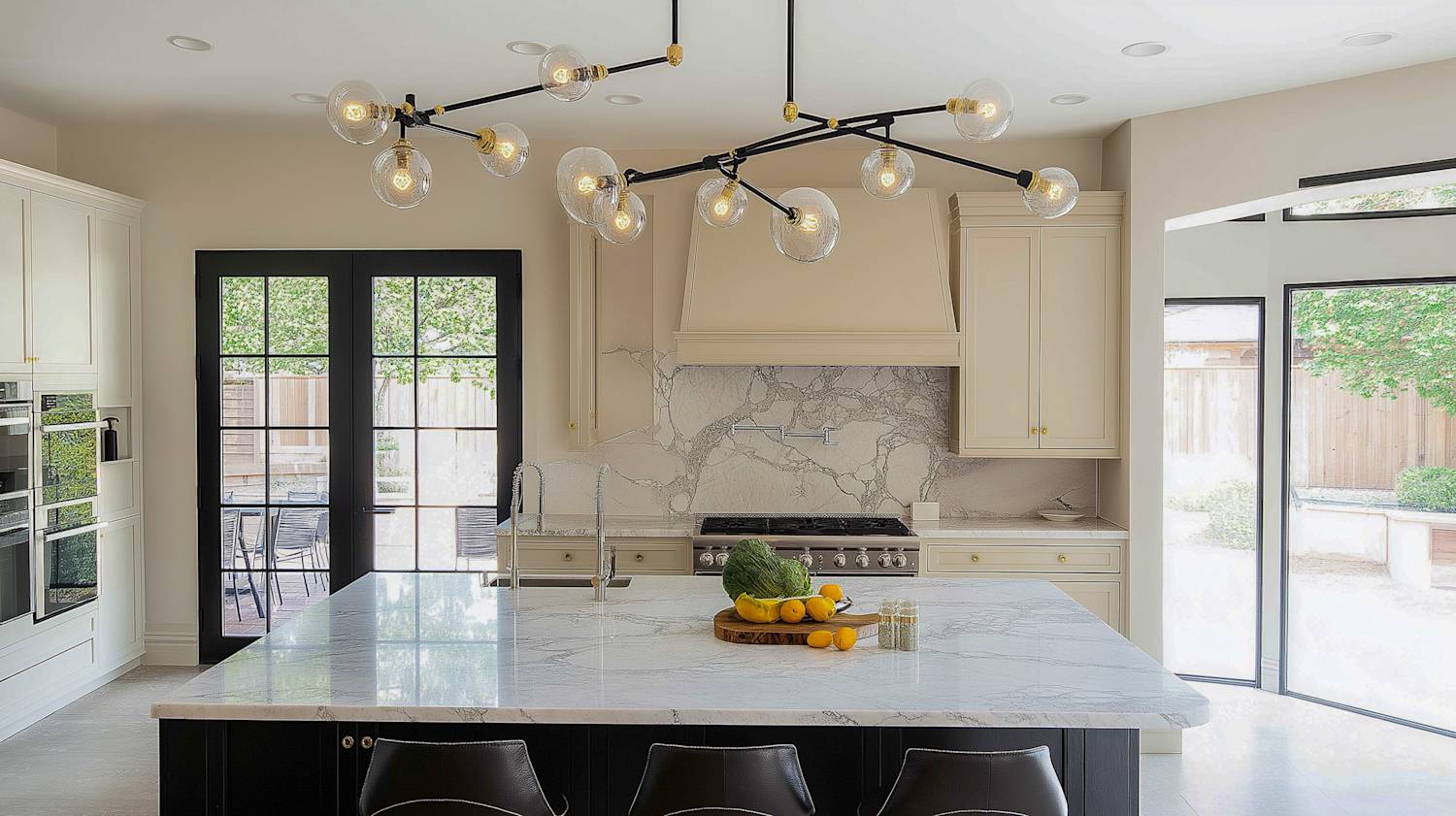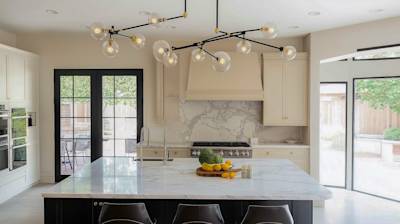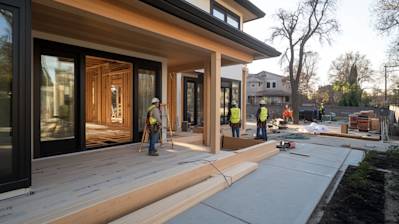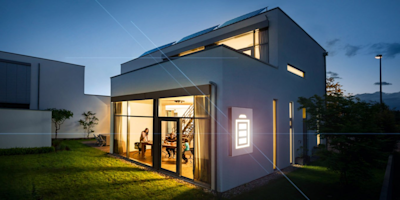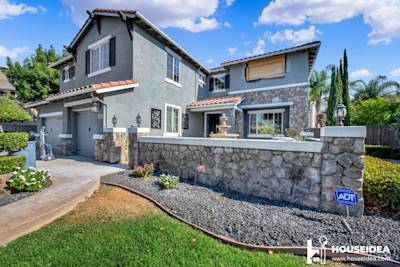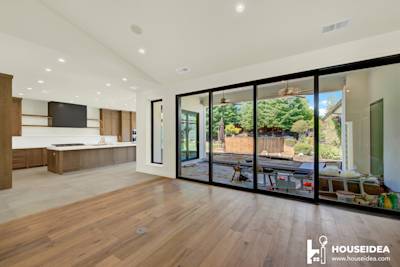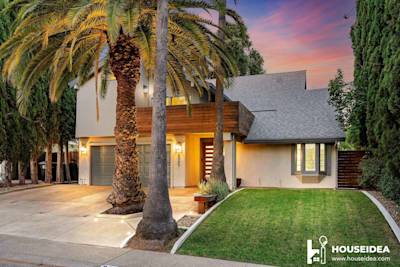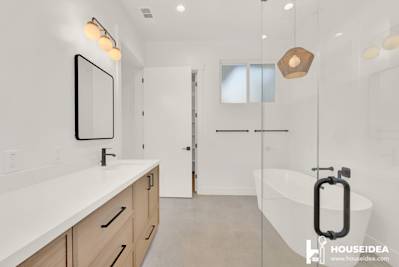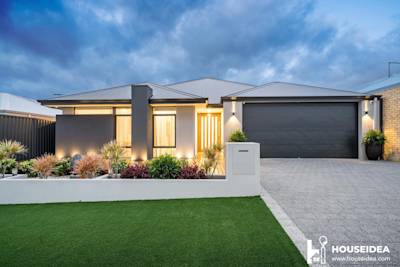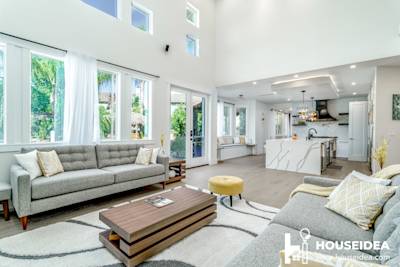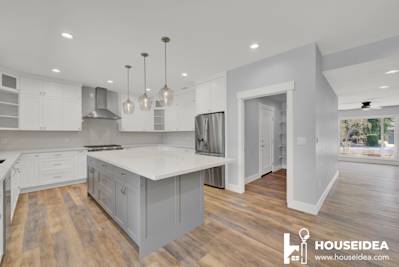The heart of every home, your kitchen, is not just where meals are prepared. It's also a bustling hub for family gatherings, casual interactions, and entertaining guests. With that in mind, lighting plays a pivotal role in enhancing the overall aesthetic and functionality. This guide delves into the world of kitchen light fixtures, helping you select the perfect match for your culinary sanctuary.
Understanding the Role of Lighting in Your Kitchen
Whether you're reading a cookbook, prepping ingredients, or cleaning up, having the right light fixtures makes these tasks easy and adds ambiance to your kitchen. It starts with understanding the three core types of lighting:
Ambient Lighting: This is the base level of light in your kitchen, providing a soft glow that banishes shadows and easily navigates the room. Recessed ceiling lights are a common source of ambient light.
Task Lighting: Targeted to specific areas where you perform tasks, like the stove or kitchen island. Under-cabinet lights are a great example.
Accent Lighting: Used sparingly to highlight design aspects such as architectural features or artwork.
How to Choose the Perfect Kitchen Light Fixtures
When it comes to lighting, one size certainly does not fit all. Here’s a comprehensive guide to distinct kitchen light fixture types:
Pendant Lights
Pendant lights hang from the ceiling, providing both task and decorative lighting. They’re perfect for kitchen islands, breakfast bars, or dining areas within the kitchen.
- Style: They come in a wide range of styles from industrial to farmhouse, so you're sure to find something to align with your kitchen's theme.
- Number and Spacing: The size of your island or countertop will determine the number of pendant lights you need. Ideally, they should be spaced about 30 inches apart and hung 30-36 inches above the countertop.
Chandeliers
Chandeliers make stunning focal points, especially in traditional or large kitchens.
- Placement: It’s essential to hang your chandelier where it won't interfere with your daily activities.
- Size: To determine the ideal chandelier size, add the dimensions of your room in feet, and then translate that number to inches. For instance, a 12-foot by 12-foot room would require a 24-inch chandelier.
Recessed Lighting
Recessed lights provide effective ambient lighting when installed across the kitchen ceiling and task lighting when placed above work areas.
- Size: Available in various sizes (4 to 7 inches in diameter), smaller lights provide a more modern look, while larger ones give a more traditional feel.
- Spacing: To avoid shadowy spots, recessed lights should be spaced about 6 feet apart in an 8-foot ceiling.
Under-Cabinet Lighting
Under-cabinet lights supply task lighting to your counter spaces, making it easier to prepare meals. LED strip lights and puck lights are the most popular choices for this type of lighting.
- Installation: Install towards the front to maximize light on the countertop.
- Affordability: LED lights are energy-efficient and last longer, which makes them a cost-effective option.
Zones Matter: Designing Kitchen Lighting
Remember to consider zones when planning your kitchen lighting. Having multiple light sources allows you to adjust lighting based on your needs and moods. A few suggestions include:
- Over the Sink: Combine task and accent lighting like a pendant or recessed lighting.
- Kitchen Island: Opt for stylish pendant lights or a modern chandelier.
- Dining Area: Warm, dimmable lights like a chandelier or wall sconces.
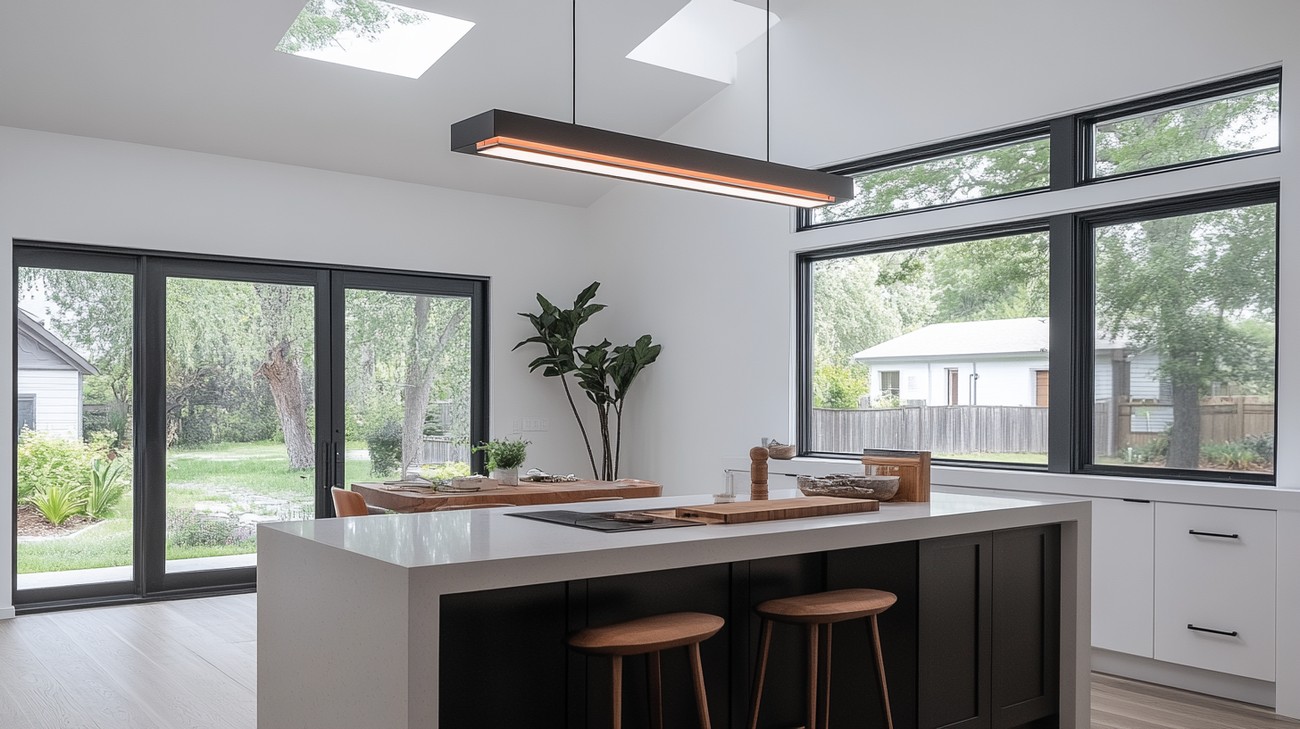
Frequently Asked Questions about Kitchen Light Fixtures
How do I choose the right kitchen light fixture?
Choosing the right kitchen light fixtures depends on several factors. These include your lighting needs, the size of the space, the kitchen layout, the décor style, and your budget. For example, an ambient light fixture can be paired with task lights over the counter for a layered lighting effect.
Are LED lights good for kitchen light fixtures?
Yes, LED lights are a great choice for kitchen light fixtures. Not only are they energy-efficient, but they also have a long lifespan. LED lights provide bright, quality light which is useful for task lighting.
What's the optimum height to hang kitchen light fixtures?
The optimum height to hang a kitchen light fixture depends on its location. Over a kitchen island, the bottom of the light fixture should ideally be 30 to 36 inches above the counter. For a kitchen table, the fixture should hang about 28 to 34 inches above it. However, these heights may vary depending on the specific design and purpose of the light fixture.
Can I install kitchen light fixtures by myself?
While some light fixtures are simple to install, others require professional installation. If you're replacing a fixture with one that has the same wiring, installation can be done by yourself. However, if you need to drill additional holes or modify the electrical setup, it’s recommended to hire a professional electrician.
How should I clean kitchen light fixtures?
Cleaning methods for kitchen light fixtures depend on the type of fixture material. Glass and crystal light fixtures can be cleaned with a mild detergent and warm water solution, while metal fixtures should ideally be wiped with a soft, dry cloth. Always ensure the light fixture is off before cleaning.
Are kitchen light fixtures dimmable?
Yes, many types of kitchen light fixtures are dimmable. However, it's essential to note that both the fixture and the light bulb need to be compatible with dimming. Dimmable kitchen light fixtures can help set the mood and adjust visibility as per the task at hand.
How often should I replace kitchen light fixtures?
The frequency of replacing kitchen light fixtures often depends on their usage and quality. If a light fixture starts to show signs of wear, such as flickering, humming sounds, or it's not providing sufficient light, it may be time to replace it. On average, a well-maintained kitchen light fixture can last between 10-20 years.
Can kitchen light fixtures be recycled or repurposed?
Some parts of the kitchen light fixtures, especially metal components, may be recycled at local recycling centers. Repurposing, on the other hand, relies on your creativity! Old kitchen light fixtures can be turned into artistic plant holders, bird feeders, or outdoor décor items.

Pros of Kitchen Light Fixtures
Improved Visibility
Better Food Preparation
Kitchen light fixtures bring a significant improvement in visibility in your cooking space. With adequate lighting, you can efficiently prepare your meals without worrying about inadequate lighting. Proper lighting reduces errors that often occur while cooking, resulting in better and tastier meals.
Enhanced Safety
Proper lighting reduces the chances of accidents because you can clearly see everything. Good lighting in the kitchen is essential, especially on the countertops or stove, where you handle sharp and potentially dangerous objects.
Aesthetic Appeal
Adds Character to Your Kitchen
Kitchen light fixtures dynamically enhance the aesthetic appeal of your kitchen. Depending on your personal style, you can choose from a variety of fixtures such as pendants, under-cabinet light fixtures, recessed lights or chandeliers. Each kind of fixture adds a unique character and charm to your kitchen.
Sets Mood and Atmosphere
Besides functionality, kitchen lights can set the mood of the kitchen, making the environment more inviting. Bright lights create an energetic atmosphere while dim lights foster a relaxed and intimate setting.
Spotlights Key Areas
With the right kitchen lights, you can highlight specific features of your kitchen that you'd like to emphasize. You could use spotlight fixtures to highlight a beautiful tile backslash or a recessed fixture to showcase a unique countertop.
Energy Efficiency
Energy-saving options
There are numerous energy-efficient light fixtures available these days. Switching to LED lights, for example, significantly reduces your power consumption without compromising on light quality.
Environmentally friendly
Choosing energy-efficient light fixtures not just helps you save money but also contributes towards conserving the environment. LED lights, for example, emit less CO2 and mercury waste, making them a green option.
Cons of Kitchen Light Fixtures
Cost
Expensive to Purchase and Install
High-quality kitchen light fixtures can be quite pricey to acquire, especially if you opt for designer or feature lights. Additionally, the installation costs can also add up, especially if you need to hire a professional electrician.
Maintenance Costs
Once installed, light fixtures may also require a degree of upkeep. This could be in the form of cleaning, bulb replacements, or fixing minor electric faults.
Installation Difficulties
Require Professional Installation
Some types of light fixtures require professional installation, which can be a complex process if you are not handy or familiar with electrical work.
Potential for Electrical Issues
Improper installation of light fixtures could lead to severe electrical problems in the long run. Therefore, it’s always safer to hire a professional.
Limited Design Options
Depends on Kitchen Setup
Your choice of kitchen light fixtures largely depends on the current setup of your kitchen. Some designs may not harmonize with the layout, making it challenging to achieve your desired aesthetic.
May Not Match with Other Components
When choosing kitchen light fixtures, you have to consider matching the fixtures with the color scheme and style of your kitchen. The wrong choice of a fixture can stick out like a sore thumb and ruin the overall aesthetic.
Increase in Energy Bill
Higher Power Consumption
Even though many energy-saving light options exist, some light fixtures may still consume a lot of power and contribute to a higher electricity bill.
Frequent Usage
Given the kitchen is one of the most used parts of a home, lights in this area tend to be switched on frequently. This continuous use could lead to a rise in energy consumption.
Conclusion
Therefore, while light fixtures can dramatically enhance the look and functionality of your kitchen, it’s crucial to consider the pros and cons before making a choice. Understanding these factors will help you choose an option that matches not only your personal style but also your budget. Always remember, the beauty of a kitchen isn't only dependent on its light fixtures!

Myths and Misconceptions about Kitchen Light Fixtures
Kitchen light fixtures are an essential part of every home. They help create the right ambience and improve the functionality of the space. However, due to a plethora of information and misinformation available, there are numerous myths and misconceptions about kitchen light fixtures. Here, we are setting out to debunk them.
Myth 1: All You Need Is Overhead Lighting
One Light Source Is Enough
Many people believe that having just one overhead light source is enough to illuminate their kitchen. However, the truth is different. Relying on one light can create shadows in the corners and prevent the light from reaching parts of the kitchen where you need it the most, such as the food preparation area or the stove.
The Solution
To avoid this issue, consider incorporating layered lighting into your kitchen. This can include task lighting focused on particular areas such as the stove or sink, and ambient lighting to create a warm and inviting atmosphere.
Myth 2: The Bigger the Light Fixture, the Better
Larger Fixtures Provide More Light
Another common misconception is that having larger light fixtures will provide more light. In reality, the amount of light is not determined by the size of the fixture, but the type and power of the bulb used.
The Issue with Bigger Fixtures
Bigger fixtures can create a disproportionate look in your kitchen. They could even be a nuisance by obstructing the view or even posing a risk of people hitting their heads against them.
Right Fixture Size
Choosing the right size of the fixture is crucial for aesthetics and practicality. Fixtures above kitchen islands, for instance, should be proportionate with the island and hang at a height that does not obstruct the view or pose any risk.
Myth 3: Brighter Lights Are Better
Bright is Good
Many people believe that the brighter the kitchen light, the better. High-intensity light can indeed help in performing tasks easily. However, they can also cause eye strain when used continuously.
The Solution
Instead of opting for maximum brightness, choose adaptive lighting solutions. This can mean having rheostat controls (dimmers) or separate task lighting with a higher lumen output spotlight and adjustable, more ambient lighting elsewhere.
Myth 4: Kitchen Lights Are Just for Functionality
Lights Only Serve Practicality
A common misconception is that kitchen lights serve only a functional purpose. However, the design of light fixtures contributes significantly to the overall visual appeal of the space.
Lights as Decorative Elements
Light fixtures can indeed play a fantastic role in the décor of your kitchen. Pendant lights in contemporary designs or vintage chandeliers can add a wonderful aesthetic appeal. Under-cabinet or in-drawer lighting can also contribute a posh, premium feel to your kitchen.
Myth 5: Energy-Efficient Lights Are Not Bright Enough
Energy Efficiency and Brightness
Some people believe that energy-efficient bulbs cannot produce bright light. This is not true, as the brightness of a bulb is indicated by its lumen count, not its energy usage (watts).
LED Lights
LED lights, for example, are notably energy-efficient and can emit a range of brightness levels, from soft ambient lighting to intense task lighting.
By dispelling these myths, you can understand the nuances involved in choosing the right light fixtures for your kitchen. From aesthetics to functionality, a lot more goes into kitchen lighting than simply flipping a switch.
Summary
So, you see, choosing the right kitchen light fixtures can have a much bigger impact than just illuminating your cooking space. It can transform the overall aesthetic of the kitchen, enhance functionality, and even improve your mood while preparing meals. It's important to consider the style, size, and brightness level to ensure they match your kitchen's design and your specific needs.
Kitchen light fixtures, when chosen and positioned properly, can indeed transform your kitchen into a warm and welcoming space. They come in various designs ranging from vintage, contemporary, industrial, or minimalist, and they can be ceiling-mounted, pendant, chandelier, or under-cabinet types. With such a wide variety of options, it's indeed possible to turn your kitchen into a space that reflects your personal style and taste.
Lastly, let's not forget about energy efficiency. Modern kitchen light fixtures, especially those with LED technology, consume significantly less electricity compared to their older counterparts. This can help reduce energy costs without sacrificing the quality of light in your kitchen. So, next time you're upgrading your kitchen or merely replacing a burnt-out bulb, give some thought to the light fixtures you're using. They might just be the key to transforming your kitchen into a brighter, more efficient, and potentially more inspiring space.
About HouseIdea
HouseIdea, situated in the vibrant heart of Sacramento, CA, is your friendly neighborhood home improvement and décor company. We're all about bringing those Pinterest-perfect aesthetics to life! From the bedroom to the kitchen, wee add that splash of comfort and style to your everyday living spaces. Since we believe in that personal touch, our team takes care around understanding your unique tastes and specific needs. We put our heart into transforming houses into homes - ones that you'll adore. Let's turn your 'House' into an 'Idea' of beauty and functionality with us!
Tags: kitchen lighting, ceiling lights, pendant fixtures,

